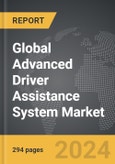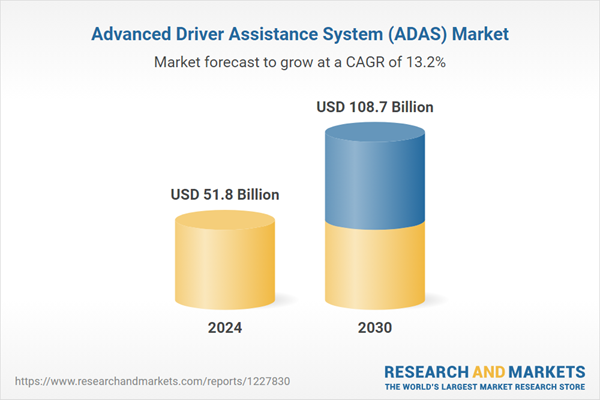The global market for Advanced Driver Assistance System (ADAS) was valued at US$51.8 Billion in 2024 and is projected to reach US$108.7 Billion by 2030, growing at a CAGR of 13.2% from 2024 to 2030. This comprehensive report provides an in-depth analysis of market trends, drivers, and forecasts, helping you make informed business decisions. The report includes the most recent global tariff developments and how they impact the Advanced Driver Assistance System (ADAS) market.
The adoption of ADAS is rapidly accelerating, driven by a combination of regulatory mandates and growing consumer demand for enhanced vehicle safety. Governments around the world are implementing stringent safety regulations that require automakers to incorporate advanced safety features into their vehicles. For instance, the European Union has mandated the inclusion of technologies such as automatic emergency braking and lane-keeping assist in all new cars, aiming to reduce traffic fatalities and serious injuries. In the United States, the National Highway Traffic Safety Administration (NHTSA) has been actively promoting the adoption of ADAS through various initiatives and regulations. Concurrently, consumers are becoming increasingly aware of the safety benefits offered by ADAS, leading to a surge in demand for vehicles equipped with these advanced features. The automotive industry is responding to this demand by investing heavily in research and development to improve the capabilities and reliability of ADAS. Advancements in artificial intelligence and sensor technology are continuously enhancing the performance of these systems, making them more effective and accessible to a broader range of vehicles, from luxury cars to more affordable models.
The growth in the ADAS market is driven by several factors. Firstly, the increasing emphasis on vehicle safety and the implementation of stringent government regulations are compelling manufacturers to integrate ADAS features into their vehicles to comply with safety standards and enhance consumer appeal. Secondly, rapid advancements in sensor technology, including significant improvements in radar, LiDAR, and camera systems, are enhancing the accuracy and functionality of ADAS, making these systems more reliable and effective. Thirdly, rising consumer awareness and demand for safety features are accelerating the adoption of ADAS, as more drivers prioritize safety in their vehicle purchase decisions. Additionally, the growing trend towards autonomous driving is driving substantial investment and innovation in ADAS technologies, as these systems are essential building blocks for the development of self-driving cars. Moreover, collaborations and partnerships between automotive manufacturers and technology companies are fostering innovation and expediting the commercialization of advanced ADAS features. Finally, the expansion of electric vehicles (EVs) and their integration with ADAS technologies are contributing to market growth, as EV manufacturers often emphasize advanced safety and automation features in their vehicle designs. This multifaceted growth is not only reshaping the automotive landscape but also paving the way for a future where fully autonomous vehicles become a mainstream reality.
Segments: Type (Adaptive Cruise Control, Autonomous Emergency Braking, Park Assist, Tire Pressure Monitoring, Forward Collision Warning, Blind Spot Detection, Lane Departure Warning System, Other Types); Component (Radar, Sensor, LiDAR, Camera).
Geographic Regions/Countries: World; United States; Canada; Japan; China; Europe (France; Germany; Italy; United Kingdom; and Rest of Europe); Asia-Pacific; Rest of World.
The analysts continuously track trade developments worldwide, drawing insights from leading global economists and over 200 industry and policy institutions, including think tanks, trade organizations, and national economic advisory bodies. This intelligence is integrated into forecasting models to provide timely, data-driven analysis of emerging risks and opportunities.
Advanced Driver Assistance System (ADAS) - Key Trends and Drivers
Advanced Driver Assistance Systems (ADAS) represent a transformative leap in automotive technology, integrating a range of sensors, cameras, and sophisticated software to enhance vehicle control and driver awareness. These systems encompass a variety of features designed to improve safety and convenience on the road. Key components of ADAS include adaptive cruise control, which automatically adjusts the vehicle's speed to maintain a safe following distance; lane-keeping assist, which helps prevent unintentional lane departures; automatic emergency braking, which can detect obstacles and apply the brakes to avoid or mitigate collisions; and blind-spot detection, which alerts drivers to vehicles in adjacent lanes. By leveraging advanced technologies like radar, LiDAR, and machine vision, ADAS can monitor the vehicle's surroundings in real-time, providing feedback to the driver or taking corrective actions to prevent accidents. The integration of these systems not only enhances road safety but also lays the groundwork for the future development and adoption of fully autonomous vehicles.The adoption of ADAS is rapidly accelerating, driven by a combination of regulatory mandates and growing consumer demand for enhanced vehicle safety. Governments around the world are implementing stringent safety regulations that require automakers to incorporate advanced safety features into their vehicles. For instance, the European Union has mandated the inclusion of technologies such as automatic emergency braking and lane-keeping assist in all new cars, aiming to reduce traffic fatalities and serious injuries. In the United States, the National Highway Traffic Safety Administration (NHTSA) has been actively promoting the adoption of ADAS through various initiatives and regulations. Concurrently, consumers are becoming increasingly aware of the safety benefits offered by ADAS, leading to a surge in demand for vehicles equipped with these advanced features. The automotive industry is responding to this demand by investing heavily in research and development to improve the capabilities and reliability of ADAS. Advancements in artificial intelligence and sensor technology are continuously enhancing the performance of these systems, making them more effective and accessible to a broader range of vehicles, from luxury cars to more affordable models.
The growth in the ADAS market is driven by several factors. Firstly, the increasing emphasis on vehicle safety and the implementation of stringent government regulations are compelling manufacturers to integrate ADAS features into their vehicles to comply with safety standards and enhance consumer appeal. Secondly, rapid advancements in sensor technology, including significant improvements in radar, LiDAR, and camera systems, are enhancing the accuracy and functionality of ADAS, making these systems more reliable and effective. Thirdly, rising consumer awareness and demand for safety features are accelerating the adoption of ADAS, as more drivers prioritize safety in their vehicle purchase decisions. Additionally, the growing trend towards autonomous driving is driving substantial investment and innovation in ADAS technologies, as these systems are essential building blocks for the development of self-driving cars. Moreover, collaborations and partnerships between automotive manufacturers and technology companies are fostering innovation and expediting the commercialization of advanced ADAS features. Finally, the expansion of electric vehicles (EVs) and their integration with ADAS technologies are contributing to market growth, as EV manufacturers often emphasize advanced safety and automation features in their vehicle designs. This multifaceted growth is not only reshaping the automotive landscape but also paving the way for a future where fully autonomous vehicles become a mainstream reality.
Report Scope
The report analyzes the Advanced Driver Assistance System (ADAS) market, presented in terms of units. The analysis covers the key segments and geographic regions outlined below.Segments: Type (Adaptive Cruise Control, Autonomous Emergency Braking, Park Assist, Tire Pressure Monitoring, Forward Collision Warning, Blind Spot Detection, Lane Departure Warning System, Other Types); Component (Radar, Sensor, LiDAR, Camera).
Geographic Regions/Countries: World; United States; Canada; Japan; China; Europe (France; Germany; Italy; United Kingdom; and Rest of Europe); Asia-Pacific; Rest of World.
Key Insights:
- Market Growth: Understand the significant growth trajectory of the Adaptive Cruise Control segment, which is expected to reach US$34.7 Billion by 2030 with a CAGR of a 15.3%. The Autonomous Emergency Braking segment is also set to grow at 14.3% CAGR over the analysis period.
- Regional Analysis: Gain insights into the U.S. market, valued at $14.3 Billion in 2024, and China, forecasted to grow at an impressive 12.4% CAGR to reach $16.6 Billion by 2030. Discover growth trends in other key regions, including Japan, Canada, Germany, and the Asia-Pacific.
Why You Should Buy This Report:
- Detailed Market Analysis: Access a thorough analysis of the Global Advanced Driver Assistance System (ADAS) Market, covering all major geographic regions and market segments.
- Competitive Insights: Get an overview of the competitive landscape, including the market presence of major players across different geographies.
- Future Trends and Drivers: Understand the key trends and drivers shaping the future of the Global Advanced Driver Assistance System (ADAS) Market.
- Actionable Insights: Benefit from actionable insights that can help you identify new revenue opportunities and make strategic business decisions.
Key Questions Answered:
- How is the Global Advanced Driver Assistance System (ADAS) Market expected to evolve by 2030?
- What are the main drivers and restraints affecting the market?
- Which market segments will grow the most over the forecast period?
- How will market shares for different regions and segments change by 2030?
- Who are the leading players in the market, and what are their prospects?
Report Features:
- Comprehensive Market Data: Independent analysis of annual sales and market forecasts in US$ Million from 2024 to 2030.
- In-Depth Regional Analysis: Detailed insights into key markets, including the U.S., China, Japan, Canada, Europe, Asia-Pacific, Latin America, Middle East, and Africa.
- Company Profiles: Coverage of players such as Aisin Corporation, Aptiv PLC, Autoliv, Inc., Continental AG, Denso Corporation and more.
- Complimentary Updates: Receive free report updates for one year to keep you informed of the latest market developments.
Some of the 43 companies featured in this Advanced Driver Assistance System (ADAS) market report include:
- Aisin Corporation
- Aptiv PLC
- Autoliv, Inc.
- Continental AG
- Denso Corporation
- Faurecia Clarion Electronics Co., Ltd.
- Garmin Ltd.
- Hitachi Astemo Ltd.
- Hyundai Mobis Co., Ltd.
- Infineon Technologies AG
Tariff Impact Analysis: Key Insights for 2025
Global tariff negotiations across 180+ countries are reshaping supply chains, costs, and competitiveness. This report reflects the latest developments as of April 2025 and incorporates forward-looking insights into the market outlook.The analysts continuously track trade developments worldwide, drawing insights from leading global economists and over 200 industry and policy institutions, including think tanks, trade organizations, and national economic advisory bodies. This intelligence is integrated into forecasting models to provide timely, data-driven analysis of emerging risks and opportunities.
What’s Included in This Edition:
- Tariff-adjusted market forecasts by region and segment
- Analysis of cost and supply chain implications by sourcing and trade exposure
- Strategic insights into geographic shifts
Buyers receive a free July 2025 update with:
- Finalized tariff impacts and new trade agreement effects
- Updated projections reflecting global sourcing and cost shifts
- Expanded country-specific coverage across the industry
Table of Contents
I. METHODOLOGYII. EXECUTIVE SUMMARY2. FOCUS ON SELECT PLAYERSIII. MARKET ANALYSISCANADAITALYREST OF EUROPEREST OF WORLDIV. COMPETITION
1. MARKET OVERVIEW
3. MARKET TRENDS & DRIVERS
4. GLOBAL MARKET PERSPECTIVE
UNITED STATES
JAPAN
CHINA
EUROPE
FRANCE
GERMANY
UNITED KINGDOM
ASIA-PACIFIC
Companies Mentioned (Partial List)
A selection of companies mentioned in this report includes, but is not limited to:
- Aisin Corporation
- Aptiv PLC
- Autoliv, Inc.
- Continental AG
- Denso Corporation
- Faurecia Clarion Electronics Co., Ltd.
- Garmin Ltd.
- Hitachi Astemo Ltd.
- Hyundai Mobis Co., Ltd.
- Infineon Technologies AG
Table Information
| Report Attribute | Details |
|---|---|
| No. of Pages | 294 |
| Published | April 2025 |
| Forecast Period | 2024 - 2030 |
| Estimated Market Value ( USD | $ 51.8 Billion |
| Forecasted Market Value ( USD | $ 108.7 Billion |
| Compound Annual Growth Rate | 13.2% |
| Regions Covered | Global |









